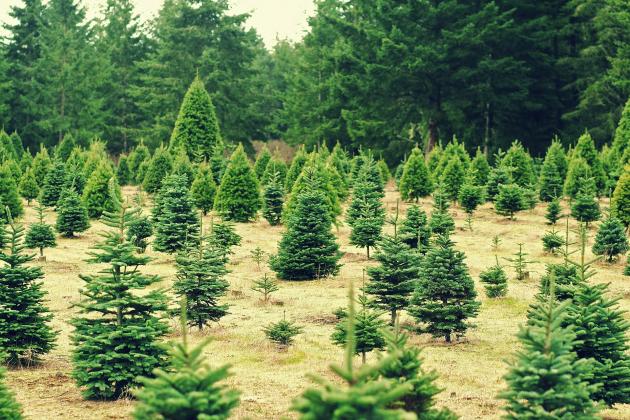
Trees ready for Christmas at a tree farm in North Carolina.
Until their time comes to grace homes with ornaments and shade presents, a natural, or live, Christmas tree will help purify groundwater, stabilize the soil, recycle air, and serve as habitat for birds, mammals, and beneficial insects. For every real Christmas tree that is sold, about nine are left to grow and mature on farms until they are cut. If you add the value of the carbon stored during the growing cycle of the tree, another environmental benefit is added. Some families also make a tradition of going out to select or cut the live tree as part of the holiday and to mark the beginning of the Christmas season. Then again, artificial trees are generally sturdier, less messy and last longer.
According to conservationists[1] and analysis of factors[2] artificial trees might seem more convenient and appear eco-friendly to some people, but the impacts of them ending up in landfill space and their environmental costs — measured in assembly, transport and use of petroleum products that produce greenhouse gas emissions — outweigh the benefits over their lifespan. Depending on what factors one chooses to consider[3] the various impacts can be ranked for consideration, but overall, the carbon footprint of a natural tree is less than an artificial tree.
It may be that the environmental effect of one artificial tree is less than an annual series of real trees, but calculations indicate that it is likely to be as much as 20 years[4] of re-use of an artificial tree for the impact to equal out. On average, households using an artificial tree replace them about every six years. Of course, how the natural tree is cultivated (fertilizer etc.) and how far either tree is transported (from the neighborhood vs. from a foreign country) influence how energy efficient the use of either type of tree is. A third option that is growing is popularity is container-grown living trees that can be planted after the holiday to grow and be enjoyed for many years. Care of the container tree for out planting includes being aware of how much time it spends inside will influence how well adapted it will be when you take it out to plant and could influence its survival.
The value of cultivating living trees to local communities includes having additional funds stay in the community to support the local tax base and family based industries. It is also possible to get a permit to cut a tree on Federal lands, or, to go to privately owned forested land to cut a tree. Cutting a tree can help thin the forest and help make a property more firesafe by creating clear (defensible) space. Considering trees as part of a total Christmas greenery package, the trees that do not make the grade for the family Christmas tree can often be used to produce greenery for wreaths, garland and center pieces for up to 30 years.
Granted, the environmental effects of the tree are small considering the many other holiday activities, for example, compared with the electricity used to light the tree, driving to pick up the tree, and even the nature of the tree stand. You can, however, consider choosing a real tree as a ‘green’ product choice.
“It makes sense to choose the tradition that suits your needs while also considering the best environmental practices,” says Kathryn Fernholz, Executive Director of Dovetail Partners, a Minneapolis-based environmental group. “If you choose a real tree, you can get to know your local grower and recycle your tree at the end of the holiday season4.”
Things to remember — trees begin to lose hardiness almost immediately once they are brought indoors and should be inside for two weeks at most. Species matters as well**. Don’t go along with sources that recommend digging a hole before the ground freezes and then planting the tree right after the holidays. This is usually the worst option. After the holidays the live tree should be kept in a protected, unheated space (porch, garage) until they are planted in the spring. Happy growing!
[1] Real Christmas Trees Save Water.
[2] Natural or artificial Christmas trees – which is ‘greener’? web.utk.edu/~mtaylo29/pages/christmas%20tree%20comparison.html — Also see the series on Christmas tree production from University of Kentucky
[3] Real Tree or Artificial Tree? http://conversableeconomist.blogspot.com/2012/12/real-tree-or-artificial-tree.html
[4] Real Versus Artificial Christmas Trees – An Environmental Perspective http://www.dovetailinc.org/content/real-versus-artificial-christmas-trees-environmental-perspective
** Trees that tend to break bud early (concolor fir, corkbark fir) and have already met their chilling requirement may begin to break bud once they are brought indoors.
References
Information from Michigan Extension: http://msue.anr.msu.edu/news/enjoy_a_living_christmas_tree_for_years_to_come and http://msue.anr.msu.edu/news/why_is_my_christmas_tree_beginning_to_grow
Couillard, Sylvain; Bage et. all. “Comparative Life Cycle Assessment (LCA) of Artificial VS Natural Christmas Tree.” Ellipsos. February 2009. published by a Montreal-based consulting firm called Ellipsos.
“Comparative Life Cycle Assessment of an Artificial Christmas Tree and a Natural Christmas Tree published in November 2010 by a Boston consulting firm called PE Americas.
